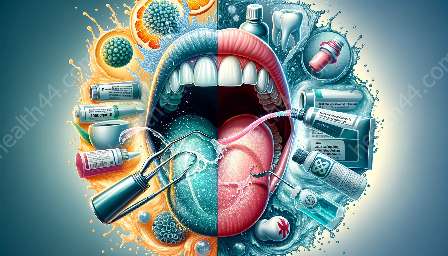Oral health is an essential aspect of overall well-being, and the use of mouthwash and rinses plays a crucial role in maintaining a healthy mouth. However, the relationship between antibacterial mouthwash and oral yeast infections is a complex and often misunderstood topic. Understanding how antibacterial mouthwash affects oral yeast infections can help individuals make informed decisions about their oral care routine.
What is Antibacterial Mouthwash?
Antibacterial mouthwash is a type of oral care product designed to reduce the number of bacteria in the mouth. It typically contains active ingredients such as chlorhexidine, cetylpyridinium chloride, or essential oils that target and kill harmful bacteria. While antibacterial mouthwash can be effective in preventing gum disease and reducing plaque buildup, its impact on oral yeast infections is a subject of debate.
Types of Oral Yeast Infections
Yeast is a type of fungus that naturally exists in the mouth, gut, and other parts of the body. In the oral cavity, the most common yeast infection is caused by Candida albicans. Oral yeast infections, also known as oral thrush or oropharyngeal candidiasis, can result in symptoms such as white patches on the tongue, inner cheeks, and roof of the mouth, as well as pain and difficulty swallowing.
Impact of Antibacterial Mouthwash on Oral Yeast Infections
The use of antibacterial mouthwash may have both positive and negative effects on oral yeast infections. On one hand, antibacterial mouthwash can help control the overgrowth of harmful bacteria in the mouth, which may indirectly impact the proliferation of yeast. By reducing bacterial competition, it can create an environment that is less favorable for yeast to flourish.
Conversely, some research suggests that the use of antibacterial mouthwash may disrupt the natural balance of microorganisms in the mouth, including the beneficial bacteria that help keep yeast in check. This imbalance can potentially lead to an overgrowth of yeast, increasing the risk of oral yeast infections. Therefore, the relationship between antibacterial mouthwash and oral yeast infections is multifaceted and can vary depending on individual factors such as oral hygiene, immune function, and overall health.
Mouthwash and Rinses as Part of Oral Care
It's important to note that not all mouthwashes are antibacterial. Some mouthwashes are designed specifically to target oral yeast infections and are formulated with antifungal agents such as nystatin or miconazole. These antifungal mouthwashes work by directly inhibiting the growth of yeast in the mouth, offering a targeted approach to addressing oral yeast infections.
For individuals who are concerned about the potential impact of antibacterial mouthwash on oral yeast infections, using antifungal mouthwashes or incorporating probiotic rinses that support a healthy oral microbiome may offer alternative strategies for maintaining oral health.
Conclusion
The relationship between antibacterial mouthwash and oral yeast infections underscores the complexity of oral microbiota and the need for personalized oral care approaches. While antibacterial mouthwash can play a role in controlling harmful bacteria in the mouth, its influence on oral yeast infections is not straightforward. Individuals should consider their specific oral health needs and consult with dental professionals to develop a comprehensive oral care routine that addresses both bacterial and yeast overgrowth.









